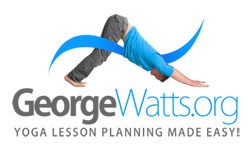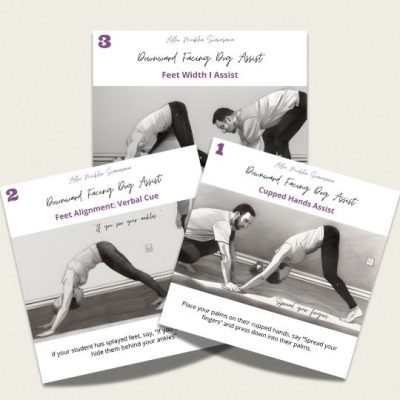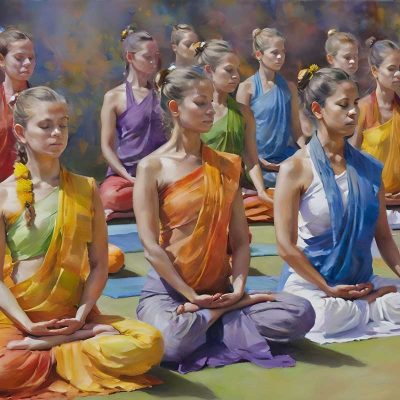A Yoga Teacher’s Guide To Maslow’s Hierarchy Of Needs
Greetings, my lovely Yogis, Yoginis, and Yoga teachers. I’m George Watts, a BWY yoga teacher and creator of the Online Yoga Lesson Planner.
Today, I’d like to share my sticky note doodle called The Yogi Guide to Maslow’s Hierarchy of Needs.
If you’re a fellow yoga teacher, you can use this post as inspiration for your next yoga class theme.
I’ve written this post as if Abraham Maslow was a Yoga teacher explaining his take on self-discovery.
It’s probably been a few years since you last looked at Maslow’s Hierarchy of Needs, so here’s my crash course on the subject.
A Quick Guide to Maslow’s Hierarchy of Needs: From Physiological (need 1) to Self-actualisation (need 5)
Maslow’s Hierarchy of Needs is a theory in psychology that describes the basic needs of humans and the order in which they must be fulfilled in order for individuals to reach their full potential.
The theory is often represented as a pyramid, with the most basic physiological needs at the bottom, followed by safety, love and belonging, esteem, and self-actualisation at the top.
According to Maslow, individuals must satisfy their most basic needs before moving up the pyramid to fulfil their higher-level needs.
So, now that you’ve familiarised yourself with Maslow’s needs, I think you’re ready to reach the pinnacle of your being.
Need 1
Mastering The Basics = Surrendering In Savasana
So, let’s start with the basics – physiological needs.
In yogi terms, this is all about Savasana.
If you can’t let yourself go and relax, especially at the end of a yoga class, your basics are all out of kilter.
Savasana, also known as Corpse Pose, is a crucial aspect of any yoga practice, and as Maslow, I would argue that it is the first need that must be fulfilled.
Before any other need can be met, you must first attain a state of complete relaxation and release. Savasana offers a time for the mind and body to rest, let go of tension and stress, and rejuvenate.
Without this restful state, the body and mind cannot function at their optimal level.
Maslow’s Hierarchy of Needs states that physiological needs such as food, water, and air must be met before any other needs can be addressed. I believe that Savasana should be added to this list, as it is the foundation upon which all other needs can be fulfilled.
When the body is relaxed, the breath is steady, and the mind is clear, we can then move on to address our other needs, such as safety, love and belonging, esteem, and self-actualisation. But without this first need for rest and relaxation, the other needs cannot be fully met.
So, the next time you find yourself rushing through Savasana or skipping it altogether, remember that it is the foundation of your practice and an essential component of meeting all of your other needs.
Take the time to fully relax, let go, and rejuvenate so that you can move forward with your yoga practice and your life in a state of balance and wholeness.
Actually, what am I thinking?
You’re feeling a bit stressed and need to do Savasana right now, don’t you? Yep, I thought so.
Well, I’ve got your back, so it’s time to on yours…
Savasana As Taught By Maslow
“So, let’s begin by lying down comfortably on your mat, with your arms resting by your sides and your legs slightly apart. Close your eyes, and take a few deep breaths, filling your lungs with air and then exhaling slowly.
As we lie here in Savasana, we are giving our bodies and minds a chance to rest and rejuvenate. We are releasing any tension or stress that may be held in our muscles or in our thoughts. By doing so, we are addressing our physiological needs and helping our bodies to function at their optimal level.
And as we continue to breathe deeply and relax, we may find that we move beyond simply addressing our physiological needs. We may experience a sense of peace, connectedness, and being in the present moment. This is the foundation upon which we can build our higher-level needs, such as safety, love and belonging, esteem, and self-actualisation.
So, as we lie here in Savasana, let us be fully present, fully relaxed, and fully open to the experience. Let us be grateful for the opportunity to rest and rejuvenate, and let us remember that this is the foundation of our practice.
When you’re ready to come out of Savasana, slowly and gently start to move your fingers and toes, and then slowly roll over onto your side. Take a few deep breaths here, and then gently push yourself up to a seated position.
Remember, dear yogis, that Savasana is not just a pose, it is a fundamental need that we must fulfil in order to meet our higher-level needs. So, let us make it a priority in our practice, and in our lives.”
Oh yes, I almost forgot. There’s more than one way to do Savasana. You can do Savasana with a bolster under your knees and with a rolled-up blanket across your lower back and if you want to truly go to relax-town, you’ll want to try this version of Savasana.
Next up in Maslow’s hierarchy is safety needs.
Need 2
Attaining Safety = Getting Into Child’s Pose
The second level of my Hierarchy of Needs is safety.
Safety is an important need that must be fulfilled before an individual can progress to the higher levels of the pyramid, such as love and belonging, esteem, and self-actualisation. And in yoga, one of the poses that can help us to meet this need is Balasana, or Child’s Pose.
When we practice Child’s Pose, we are folding in on ourselves, creating a sense of safety and protection. We are nurturing our inner child, which allows us to let go of any anxiety, fear or stress that we may be experiencing. It is a gentle pose that helps us to feel grounded and secure.
In addition to the emotional safety it provides, Child’s Pose is also physically beneficial. It is a gentle stretch for the hips, thighs and ankles, and it can also help to relieve tension in the back, neck, and shoulders.
Child’s Pose As Taught By Maslow
“In Child’s Pose, we curl up into a foetal position, which can provide a sense of safety and security. It is a gentle pose that can help us to feel grounded and calm.
To come into Child’s Pose, begin on your hands and knees. Slowly bring your hips back towards your heels, extending your arms forward or alongside your body. Let your forehead rest on the ground and breathe deeply. You can also bring your knees wider apart for a deeper stretch in the hips.
As you hold the pose, imagine yourself as a child, feeling safe and protected. Allow yourself to let go of any worries or fears that you may be holding onto. Let the pose support and nurture you.
Child’s Pose is also a fab physical stretch for the hips, thighs, and ankles. It can help to relieve tension in the back, neck, and shoulders. It is a restorative pose that can be practised anytime, anywhere, especially when you need to take a break and feel grounded.
Let’s make Child’s Pose a regular part of our practice to honour our need for safety.”
Let’s move on to love and belonging.
Need 3
Love & Belonging = Practicing Partner Yoga
I would like to talk to you about the third level of my Hierarchy of Needs, which is love and belonging.
As a yoga teacher, I believe that love and belonging start with self-love. So, give yourself a big hug and repeat after me:
“I am enough. I am worthy of love and belonging.”
And if you’re feeling extra lonely, go to a local yoga class – they tend to be one big happy yoga family.
As human beings, we have a fundamental need to feel loved and to belong. And in yoga, one way to meet this need is through Partner Yoga.
Partner Yoga is a practice in which two people work together to create poses and sequences. It is a beautiful way to connect with another person and experience the joy of giving and receiving support. It can help us to cultivate a sense of trust, compassion, and empathy towards ourselves and others.
In Partner Yoga, we learn to rely on one another, both physically and emotionally. We become more aware of our own needs and the needs of our partners. We learn to communicate in a new way, to listen deeply, and to respond with kindness and love.
Partner Yoga is not only a way to meet our need for love and belonging, but it also has physical benefits. It can help to deepen our stretches, improve our balance, and increase our flexibility. It can also be a fun way to challenge ourselves and try new things.
Camel Partner Pose As Taught By Maslow
“Practising a Partner Yoga pose that can help us to cultivate a deeper sense of connection and trust with our partner – Camel Partner Pose.
To practice Camel Partner Pose, Partner A and Partner B face each other in a kneeling position. Interlock your arms and lean backwards, allowing your head to drop back and your heart to open towards your partner. Hold the pose for several breaths, feeling the support and connection between you and your partner.
As you practice this pose, remember to communicate with your partner, to listen and respond to their needs. Allow yourselves to surrender into the pose and trust one another.
Camel Partner Pose is not only a beautiful way to connect with your partner, but it also has physical benefits. It can help to stretch the chest, abdomen, and thighs, and improve posture and balance. It can also help to release tension and open the heart.
So, if you’re a Yoga teacher don’t be afraid to add some Partner Yoga poses to your classes because they help to honour our need for love and belonging.
Let’s move on to self-esteem.
Need 4
Self-esteem = A Daily Yoga Practice

Daily Yoga Practice
Let’s talk about the fourth level of my Hierarchy of Needs through the eyes of me, Maslow, a reincarnated Yoga teacher.
Esteem refers to our need for self-respect, confidence, and a sense of achievement. One way to meet this need is through daily yoga practice.
When we commit to a daily yoga practice, we are honouring ourselves and our bodies, and saying to ourselves:
“I am worth this time and effort.”
We are building self-respect and self-confidence, as we challenge ourselves and see progress in our practice.
Daily yoga practice also gives us a sense of achievement.
We set goals for ourselves, and as we progress, we feel a sense of accomplishment. We may start with simple poses and gradually move towards more challenging ones, or we may focus on building strength or flexibility. Whatever our goals may be, daily yoga practice helps us to see the progress we are making.
In addition to building self-esteem, daily yoga practice also has physical and mental benefits. It can help to improve our strength, flexibility, and balance. It can also help to reduce stress and anxiety and improve our overall sense of well-being.
So, let us challenge ourselves, build self-respect and self-confidence, and experience the joy of daily practice.
And finally, self-actualisation.
Need 5
Self-actualisation = Practising Crow Pose Without Tipping Over
Self-actualisation is what we’re all striving for, right?
It refers to our need for personal growth, creativity, and fulfilment of our potential.
My version of self-actualisation has got to be Crow pose without falling flat on my nose!
Crow Pose, also known as Bakasana, is an arm balance pose that requires strength, balance, and focus.
Crow Pose As Taught By Maslow
“To practice Crow Pose, come into a squatting position with your feet hip-width apart. Place your hands on the mat in front of you, shoulder-width apart, and spread your fingers wide.
Then, lift your hips up and begin to shift your weight forward, until your knees rest on your upper arms.
Slowly begin to lift your feet off the ground, shifting your weight forward until you find balance.
Hold the pose for several breaths, then slowly release and come back to a squatting position.”
But Crow Pose is not just a physical challenge. It is also a pose that requires mental clarity and focus. When we practice Crow Pose, we are challenging ourselves to go beyond our perceived limits and to trust in our own abilities. We are tapping into our potential and discovering new strengths and abilities.
As we hold Crow Pose, we are also cultivating our ability to be fully present in the moment, to focus on what is important, and to tap into our creative potential. We must be fully present in the moment, concentrating on our breath and our balance. When we can achieve this level of focus, we are honing our mental skills and sharpening our focus, which is an essential part of our journey towards self-actualisation.
Namaste!
Alright, folks, it’s the grand finale, the moment you’ve all been waiting for… drumroll, please… it’s time for my epic conclusion!
George’s Conclusion
And voila, my lovely yogis, you have just witnessed Maslow’s Hierarchy of Needs from the perspective of a yoga teacher who happens to be Maslow reincarnated!
Yes, I know…I know.
This post was a bit of tongue-in-cheek humour, and I’m aware that the proper needs would have been The Five Yamas, but I recently wrote this blog post about those 5 Yummy Yamas, so I felt the urge to go with five different needs. I hope you don’t mind too much.
As yogis, we know that self-realisation is a lifelong journey, but we’re in it for the long haul. So, keep practising, keep learning, and keep growing. And who knows, maybe one day you’ll achieve enlightenment and become a full-blown yoga master!
Remember to breathe, cultivate inner peace, love yourself, embrace your awesomeness, and keep growing.
Oh yes, I almost forgot.
If you like creating yoga class themes, you’ll also love my post called 101 Perfect Poses For A Peak Pose-Themed Yoga Lesson Plan, or The Power Of Love: Lessons From The Still-face Experiment.
And, hey, you can show yourself some self-actualisation by streamlining your yoga lesson planning and checking out my Online Yoga Lesson Planner. This powerful tool can transform your classes and elevate your teaching to the next level.















